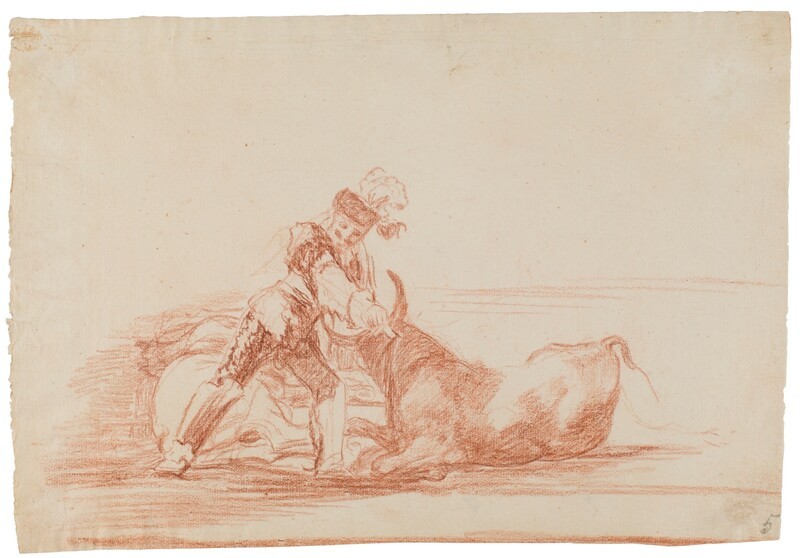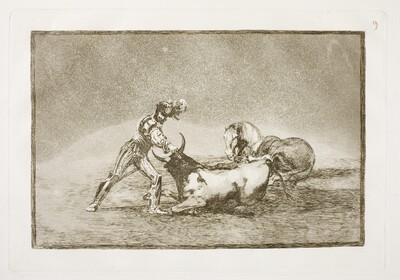- Cronología
- Ca. 1814 - 1816
- Ubicación
- The Prado National Museum. Madrid, Madrid, Spain
- Dimensiones
- 198 x 287 mm
- Técnica y soporte
- Sanguine on laid paper
- Reconocimiento de la autoría de Goya
- Documented work
- Titular
- El Prado National Museum
- Ficha: realización/revisión
- 01 Oct 2021 / 22 Jun 2023
- Inventario
- D4294
5 (in pencil; recto, lower right-hand corner)
Engraving [2nd support] (reverse, upper middle)
Watermark: GRIMAUD -- [G.S] (left half)
See How the ancient Spaniards hunted bulls on horseback in the countryside.
Javier Goya, Madrid, 1828; Mariano Goya, Madrid, 1854; Valentín Carderera, Madrid, c. 1861; Mariano Carderera, Madrid, 1880; Prado Museum, 1886.
See How the ancient Spaniards hunted bulls on horseback in the countryside.
With this scene, a sketch of the print A Spanish knight kills a bull after having lost his horse, Goya begins a new series of themes related to the chivalrous origins of bullfighting. He depicts Christian knights of various periods feasting with bulls, and the contrast between human and animal figures is striking.
As Count La Viñaza said in 1887, the knights are characterised by their inappropriate dress. In this respect, Lafuente Ferrari pointed out that this clothing was reminiscent of Velázquez's jester Don Juan de Austria. However, the forced poses do not add to the realism of the character.
As Matilla points out, when it comes to animals, especially horses, Goya shows a precise knowledge of their morphology. This sketch shows a knight and a bull, transferred quite faithfully to the print. In the background, the dead horse is shown behind its rider, while in the engraving the horse appears to be a spectator, lying on its back with its head held high. With one of its hind legs outstretched, it was clearly struggling to get up due to its injury. This is the most dramatic part of the scene, much more so than the theatrical death of the bull at the hands of the knight.
Using various compositional devices, the artist accentuates the elements that add tension to the image, such as the bull's horns forming a semi-circle, circumscribed by the hand of the knight wielding the sword. The horns and hands are tools of war between man and beast. He also suppresses spatial references and creates a focus of light on the horizon where the figures are cut out, according to Matilla.
The work is attached to a second support, a sheet of laid paper, lined with pen, belonging to a French army record book in Spain.
-
MadridMuseo del Prado1928n. 58
-
1946pp. 185, 191
-
MadridMuseo del Prado1954n. 158
-
ParísLe Club Français du Livre1963p. 66
-
Vie et ouvre de Francisco de GoyaParísOffice du livre1970p. 277, nº 1166
-
Barcelona1974pp. 6, 12
-
Dibujos de Goya, 2 volsBarcelonaNoguer1975pp. 346-347, nº 248
-
MadridMuseo Nacional del Prado2001pp. 54-55

